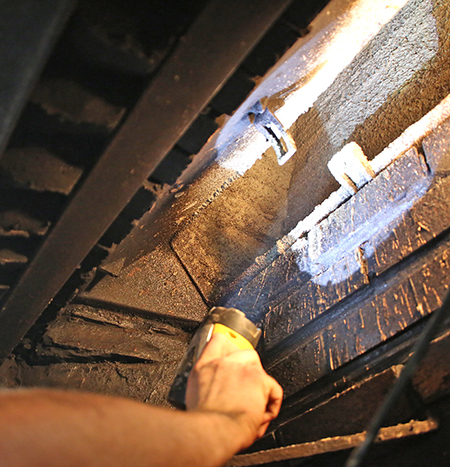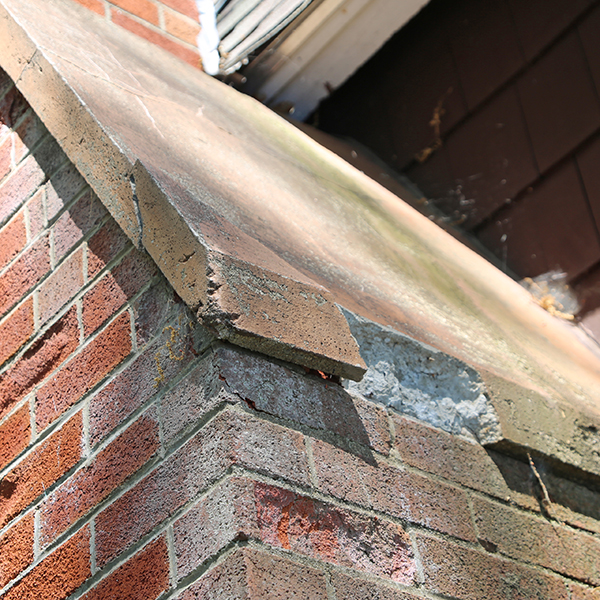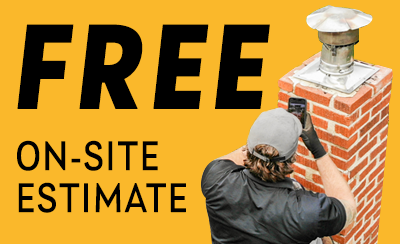Why is Water Coming in Through My Chimney?
Here in Buffalo, Rochester, and Western New York, we are accustomed to snowy winters and humid summers. However, moisture, whether it’s in the form of rain or condensation, can damage the fireplace and chimney. So, anytime you hear the sounds of dripping water in the chimney, notice water dripping or a puddle in the fireplace, it indicates a leaky chimney that needs repair. In this article, we’ll explore the five common reasons for water coming in through your chimney.
 Damper Is Open or Damaged
Damper Is Open or Damaged
An open or damaged damper is a common reason for water coming through the chimney, mainly when the fireplace is not used in the spring and summer. It is easy to forget to close the damper after a cold and busy winter season. Another reason is a damaged damper or gasket. When the metal damper is warping or corroding, has extensive creosote buildup, or has cracks in the rubber gasket, it doesn’t form an airtight seal so that water will leak through these small gaps into your fireplace.
Worn Chimney Flashing
The chimney flashing is another common source of water leaks. The sheet metal flashing creates a watertight seal where the chimney meets the roofline. Normal wear and tear, heavy snow accumulating on the roof, frequent rain, and even improper installation can cause the chimney flashing to fail, exposing the chimney to water leaks. Some of the tell-tale signs that indicate your flashing may need repair or replacement are water stains on the ceiling or walls by the fireplace. However, by the time you notice water stains, the leak may have caused water damage to your attic and roof deck, which can lead to wood rot, mold, and structural problems. So, it’s vital to have annual chimney inspections to protect your chimney and roof.
Chimney Crown Cracks
The chimney crown is the concrete surface that tops the entire masonry structure. Its purpose is to protect the interior masonry walls from water damage. However, the porous surface is prone to cracking – often due to an aging chimney, house settling, and extreme weather conditions. Even a lightning strike can cause significant damage to the chimney crown. Unfortunately, without an annual inspection, most homeowners are unaware of chimney crown cracks until more severe damage occurs.
Flue Liner Deterioration
A deteriorating flue liner also referred to as a chimney liner, is another reason for a leaky chimney. The flue liner, which may be clay tile, concrete, or flexible metal tubing, helps ensure that the smoke and fumes vent out the chimney, protecting the interior masonry from the intense heat in the fireplace. In addition, when the flue liner deteriorates, the hot gasses in the flue can spread to nearby combustible building materials like the framing, attic, or roof deck and start a chimney or house fire. A damaged flue liner can also expose your family to toxic carbon monoxide fumes when using the fireplace or heating stove.
 Masonry Damage
Masonry Damage
We also see cases where masonry damage is the source of one or more chimney leaks. The freezing, rain, snow, and ice in the winter combined with wet and humid summers can cause the porous brick and mortar surface to chip, crack, and spall. The decaying mortar exposes gaps in the mortar joints, allowing water to leak through the chimney. As a result, some bricks may loosen and even fall off the chimney. In addition, to chimney leaks, widespread masonry damage can destabilize the structure, leading to a partial or complete collapse that will require an expert chimney rebuild.
Chimney Leak Repairs in Western New York
If you suspect you may have a chimney leak, call (716) 907-4914 or (585) 308-4914 to schedule an appointment with the certified chimney experts at Felgemacher Masonry and Chimney. You can also contact us online. We have been serving the Western New York community since 1953.



